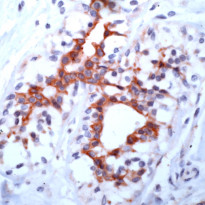ARG53020
anti-FGFR3 antibody
anti-FGFR3 antibody for IHC-Formalin-fixed paraffin-embedded sections and Human
Cancer antibody; Cell Biology and Cellular Response antibody; Developmental Biology antibody; Signaling Transduction antibody
Overview
| Product Description | Rabbit Polyclonal antibody recognizes FGFR3 |
|---|---|
| Tested Reactivity | Hu |
| Tested Application | IHC-P |
| Host | Rabbit |
| Clonality | Polyclonal |
| Isotype | IgG |
| Target Name | FGFR3 |
| Antigen Species | Human |
| Immunogen | Synthetic peptide derived from internal region of human FGFR-3 protein. |
| Conjugation | Un-conjugated |
| Alternate Names | CEK2; CD antigen CD333; FGFR-3; ACH; JTK4; Fibroblast growth factor receptor 3; CD333; EC 2.7.10.1; HSFGFR3EX |
Application Instructions
| Application Suggestion |
|
||||
|---|---|---|---|---|---|
| Application Note | IHC-P: Antigen Retrieval: Boil tissue section in 10mM citrate buffer, pH 6.0 for 10 min followed by cooling at RT for 20 min. Incubation Time: 30 min at RT. * The dilutions indicate recommended starting dilutions and the optimal dilutions or concentrations should be determined by the scientist. |
||||
| Positive Control | Breast, Breast Carcinoma |
Properties
| Form | Liquid |
|---|---|
| Purification | Immunogen affinity purified |
| Buffer | PBS (pH 7.6), 1% BSA and < 0.1% Sodium azide |
| Preservative | < 0.1% Sodium azide |
| Stabilizer | 1% BSA |
| Storage Instruction | For continuous use, store undiluted antibody at 2-8°C for up to a week. For long-term storage, aliquot and store at -20°C or below. Storage in frost free freezers is not recommended. Avoid repeated freeze/thaw cycles. Suggest spin the vial prior to opening. The antibody solution should be gently mixed before use. |
| Note | For laboratory research only, not for drug, diagnostic or other use. |
Bioinformation
| Database Links |
Swiss-port # P22607 Human Fibroblast growth factor receptor 3 |
|---|---|
| Background | Fibroblast growth factors (FGFs) are members of a large family of structurally related polypeptides that are potent physiological regulators of growth and differentiation for a wide variet of cells of mesodermal, ectodermal and endodermal origin. Four genes encoding for high affinity cell surface FGF receptors (FGFRs) have been identified: FGFR-1, FGFR-2, FGFR-3 and FGFR-4.FGFRs are emembers of the tyrosine kinase family of growth factor receptors. FGFR-3 is widely expressed in many fetal and adult human and animal tissues. |
| Cellular Localization | Cytoplasm |
| Research Area | Cancer antibody; Cell Biology and Cellular Response antibody; Developmental Biology antibody; Signaling Transduction antibody |
| Calculated MW | 88 kDa |
| PTM | Autophosphorylated. Binding of FGF family members together with heparan sulfate proteoglycan or heparin promotes receptor dimerization and autophosphorylation on tyrosine residues. Autophosphorylation occurs in trans between the two FGFR molecules present in the dimer. Phosphorylation at Tyr-724 is essential for stimulation of cell proliferation and activation of PIK3R1, STAT1 and MAP kinase signaling. Phosphorylation at Tyr-760 is required for interaction with PIK3R1 and PLCG1. Ubiquitinated. Is rapidly ubiquitinated after ligand binding and autophosphorylation, leading to receptor internalization and degradation. Subject to both proteasomal and lysosomal degradation. N-glycosylated in the endoplasmic reticulum. The N-glycan chains undergo further maturation to an Endo H-resistant form in the Golgi apparatus. |
Images (1) Click the Picture to Zoom In






